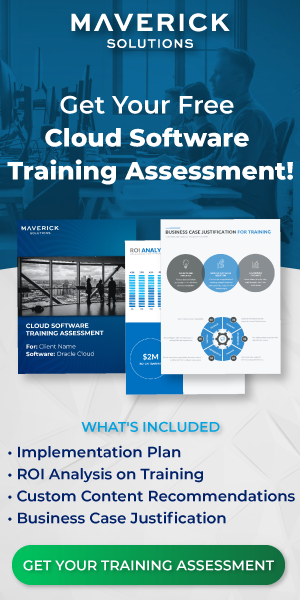Author: Danielle Gentry
Oracle Cloud Procurement is a suite of applications that your company can use to integrate your sourcing, purchasing, and supplier management processes.
Some of the key benefits for using Oracle Procurement are listed below:
- Ability to maintain electronic records of documentation in one integrated Cloud system.
- Access to personalized and interactive dashboards and infolets in most of Procurement’s work areas, which offer key information in high-level visual displays, such as graphics or charts.
- Improve supplier management and collaboration through the Supplier Portal and Suppliers work area.
- Allow for strategic sourcing functionality.
- Use of Self-Service Procurement, which provides users with a modernized and user-friendly purchasing experience, where they can use Catalogs to search for items and services, create purchase requisitions, and manage shopping lists.
- Automate and simplify your business processes, including the ability to create purchase orders directly from requisitions after their approval.
- Emphasize the importance of social collaboration within your organization, offering simple sharing and communication features.
- Ability to achieve lower risks and greater profit.
Within Oracle Cloud Procurement, you will manage the following business processes:
- Configuring Procurement
- Managing Supplier Information
- Managing a Procurement Catalog
- Managing Requisitions
- Managing Purchase Orders
- Managing Supplier Agreements
- Managing Supplier Negotiations
- Managing Supplier Contracts
Configuring your Procurement Application
When configuring your Procurement application, you will be tasked with defining a workflow for approvals. Oracle Cloud Procurement offers an automated approval management workflow that routes tasks from one user or group to another. Once an approver receives an approval request notification, they decide whether to accept or reject it. Once an action is taken, the task moves on to the next approver.
You can set up approval workflow tasks and notifications in order to satisfy your organization’s specific needs.
In addition to creating approval groups, you can configure the following items:
- The number of necessary approval levels for various items or transactions
- When users are notified regarding workflow tasks they are involved in
- Which users are assigned as approvers
Most of the workflow configurations will be done in the Business Process Management (BPM) Worklist.
Managing Supplier Information
Managing supplier information includes tasks for supplier configuration, maintenance, and registration.
Using the Suppliers work area, Supplier Administrators can complete daily supplier administrative and maintenance tasks.
The following list includes tasks involving managing suppliers and supplier information:
- Review a list of suppliers with incomplete or expired information as well as new information pending internal review.
- Manage a list of suppliers that are approved by your organization to provide specific goods or services.
- Complete supplier registration requests on behalf of an external supplier. This can be done via the Suppliers work area, Sourcing, or Self-Service Procurement.
- Review supplier registration requests to determine if your organization wishes to do business with a certain supplier.
- Approve supplier registrations.
- Create qualification questionaries to be used during the supplier qualification process.
- Create prospective and spend-authorized suppliers.
- Manage existing suppliers.
- Perform searches for potential suppliers to do business with, by using keywords and advanced search criteria.
- Interact and collaborate with suppliers by inviting them to Oracle’s Supplier Portal.
When using Oracle Cloud Procurement, you can establish your suppliers with access to the Supplier Portal. In the Supplier Portal, suppliers can quickly view and act on tasks involving their agreements, orders, shipments, and contracts.
Managing a Procurement Catalog
Catalogs are an offering within Procurement Self-Service that function as web stores for procurement requesters to browse, search for, and compare items and services before adding them to a shopping list or purchase requisition.
Catalog administrators can create and manage various types of catalogs in the Catalogs work area. Depending on your organizational needs, you may choose to use any or all of the following catalogs:
- Local catalog: Contains items and item attributes that are defined in Oracle Cloud Inventory and Purchasing. Some attributes include item descriptions, categories, and units of measure (UOM). When using this type of catalog, you are searching for items that are already housed within your Oracle application.
- Punchout catalog: Contains items that an external supplier maintains. When using this type of catalog, you are leaving the Oracle work areas and using the supplier’s actual website to search for and select items to be added to a requisition.
- Informational catalog: Contains policies pertaining to procurement, instructional material, and attachments showing how a user could order an item that is not in the other catalogs.
Managing Requisitions
Requisition management includes using catalogs and shopping lists to create purchase requisitions. A purchase requisition is an internal document requesting the purchase of an item or service. A requisition, once submitted, must be approved before the actual purchase of the requested item can be made.
Within Oracle Cloud Procurement, you will use the Purchase Requisitions work area to create and manage requisitions. Users can create requisitions manually or from a Catalog. Utilizing the available Catalogs to search for and add items to your shopping cart will automatically create a requisition. Once you have added all your items to the cart, you can submit the requisition. You can also add items to your cart that are not a part of a Catalog, these are referred to as noncatalog items. You will need to manually input the details for any noncatalog items you are requesting.
Once created and submitted for approval, a requisition is routed to one or more approvers. If the requisition is approved, a purchase order can be created by sourcing the information from the requisition.
Once a requisition is submitted, the application sends it to a requisition approver. Oracle Cloud offers an automated approval management workflow that routes tasks from one user or group to another. As a requisition approver, you will need to ensure that you are reviewing key details of the requisition before you choose to approve or reject it.
Managing Purchase Orders
Once a purchase requisition is approved, a purchase order (PO) can be created. A purchase order is a formal document from the buying organization to a supplier, indicating the details of the actual purchase of items or services.
While a purchase requisition is typically only used by those inside your company, a purchase order is sent to suppliers outside of your company.
The following list outlines various methods that can be used to create a purchase order:
- Processing an approved requisition into a purchase order using the Process Requisitions task.
- Configuring approved requisitions to be automatically converted into purchase orders.
- Using the Create Order task to manually create a purchase order.
- Duplicating an existing purchase order.
- Importing a purchase order from a third-party application into Oracle Cloud Purchasing.
Once a purchase order is submitted for approval, it is routed to one or more listed approvers. Once an approver receives an approval request, they will review the details of the request, and choose one of the following options:
- Request additional information regarding the purchase order.
- Reassign the purchase order to be reviewed by additional approvers.
- Approve the purchase order.
- Reject the purchase order.
If rejected, the purchase order is returned to its creator. If approved, the purchase order is sent to the listed suppliers.
Managing Supplier Agreements
A supplier agreement is a long-term agreement between a buyer and supplier that lists the goods or services that will be provided over a period of time. The two types of supplier agreements are described below:
- Blanket purchase agreement (BPA): Typically used when you know the details of the items or services that you want to purchase but are unsure of the delivery dates.
- Contract purchase agreement (CPA): Typically used to agree on terms and conditions with a supplier without listing the specific items that you are purchasing.
You can use the Purchase Agreements work area to create and manage supplier agreements.
Managing Supplier Negotiations
A negotiation document lists the key details of the negotiation between your organization and a potential supplier. Negotiation documents can be created in the following ways:
- By sourcing the information from a purchase requisition into a negotiation.
- By using a negotiation style, which governs the document’s appearance and features.
- By using a negotiation template, which contains a baseline for most of the information that will be included in the negotiation document.
- By manually inputting all required information for the negotiation document.
Managing Supplier Contracts
While creating a negotiation document, you are given the opportunity to create a base contract. This allows the suppliers to read over the contract terms during the negotiation review process, and either approve or reject the terms. Once the negotiation is closed and the two parties have agreed on the contract terms, individual contracts can be created for each supplier you have chosen to work with. The base contract and details provided by the supplier will be copied to create the supplier contract.
The two types of supplier contracts are detailed below, each of which can be created with or without contract lines:
- Enterprise class contract: When contract lines are included, standard POs can be generated through the supplier contract fulfillment process. Otherwise, you can create a master contract, which only contains contract terms and no contract lines, and name it on the purchase agreements created from a sourcing award.
- Agreement class contract: When lines are included, the supplier contract fulfillment process is used to create BPAs. If lines are not included, this process creates CPAs.
Additional Questions about Oracle Cloud Procurement?
We’ve covered how Oracle Cloud Procurement can help your team simplify business processes, automate offerings, and improve collaboration between your organization and external suppliers.
You can learn more about how to implement and use Oracle Procurement with ENGAGE, Maverick Solutions’ comprehensive, subscription-based training for Oracle Cloud applications.
ENGAGE is both a learning platform (ENGAGE Learn) and a GPS (ENGAGE Live) for your Oracle Cloud software.
ENGAGE Learn contains thousands of training resources and interactive training simulations that walk users step-by-step through complex business processes. ENGAGE Live is accessible in the live Oracle application and guides users in real time with any issues in the system.
Offering fully customizable Training as a Service (TaaS), Maverick Solutions can provide your organization:
- Training available anytime, anywhere
- Content that’s always current with software updates
- Interactive simulations
- Learning consultation to determine your organization’s training needs
To learn more, speak with one of our training experts today!
Note: This article was written for Oracle release 21C. Due to the nature of Cloud software and updates, this article may no longer be accurate. If you would like access to the most up-to-date version, please reach out to our team to learn more.





